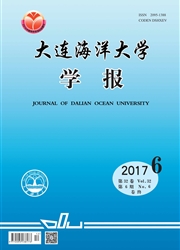

 中文摘要:
中文摘要:
对曼氏无针乌贼Sepiella maindroni(胴长2.3 mm±0.1 mm)初孵幼体投喂不同开口饵料(丰年虫、桡足类、桡足类+糠虾),对幼体乌贼(胴长12.7±0.3 mm)投喂不同饵料(活脊尾白虾、冰鲜杂鱼、干湿配合饲料)进行喂养试验,以成活率、胴长、体重等为指标进行对比分析。结果表明:桡足类组的初孵幼体成活率最高(83.3%),依次为桡足类+糠虾组、丰年虫组,成活率分别为63.9%、13.9%;桡足类+糠虾组的初孵幼体生长速度最快,平均旬生长为2.65 mm,依次为桡足类组、丰年虫组。活脊尾白虾组的幼体乌贼生长最快,平均旬生长为12 mm,依次为冰鲜杂鱼组、湿配合饲料组,平均旬生长分别为6、5mm;幼体乌贼的成活率依次为活脊尾白虾组(67.5%)〉湿配合饲料组(41.7%)〉冰鲜杂鱼组(33.3%);投喂不同饵料对曼氏无针乌贼幼体的粗蛋白、水分、粗脂肪、总灰分影响显著。
 英文摘要:
英文摘要:
Newly hatched cuttlefish Sepiella maindroni paralarva (carcass length 2.3 mm)was fed by Artemia salina, Copepoda, Copepoda and Mysidacea, and the cuttlefish juveniles( carcass length 12.7 mm)fed live Exopalaemon carinicauda, frozen fish, and wet formulated feed to elucidate effluences of diets on growth, survival and nutrient composition of the cuttlefish. The results showed that the cuttlefish paralarva fed Copepoda had the highest survival rates(83.3% ), followed by the one fed Copepoda and Mysidacea (63.9%), and then the one fed Artemia salina (13.9%). The best growth was found in the cuttlefish paralarva fed Copepoda and Mysidacea( 2. 65 mm every ten days), median growth in the squid paralarva fed Copepoda and the least in the cuttlefish paralarva fed Artemia salina. For the cuttlefish juveniles, there were the best growth in the cuttlefish fed live Exopalaemon carinicauda( 12 mm in carcass length every ten days), followed by the juveniles fed the frozen fish (6 mm every ten days), and then the cuttlefish fed the wet formulated feed (5 mm every ten days). The range of survival rates in the cuttlefish juveniles fed various diets varied in a descendant order as follows : live Exopalaemon carinicauda ( 67. 5% ) 〉 frozen fish(41.7% ) 〉 wet formulated feed (33.3%).
 同期刊论文项目
同期刊论文项目
 同项目期刊论文
同项目期刊论文
 期刊信息
期刊信息
